Orange Warner
23 June 1805 – 21 June 1881
Central New York
developed rapidly after 1783 when Congress provided land in lieu of
payment to Revolutionary War veterans. Migration was largely from the
east, mostly from New England states. Generally the settlers
preferred higher land. In time, as hillside soil was eroded by early
clearing and farming, valley lands were more fertile and highly
prized for agriculture as well as for water power, which was the
origin of many communities. The prominent community and County Seat
is Syracuse.
Of the earlier
settlers in the region was a young man by the name of Cyrus Warner
and his new bride, Mary Dodge who came from New Hampshire around
1784. Here, they began raising their family and a established large
posterity that called the area home for generations. This is the
story of their grandson, Orange Warner.
Orange Warner
was born on June 23, 1805 in Syracuse, Onondaga County, New York to
Horatio Warner (23 May 1784) and Polly Mary Burzee (1783). He was the
oldest of ten children.
He grew up in
Syracuse where at the age of 24 he married Lavina Robison, She was
born December 26, 1806 in Charleston, Montgomery County, New York to
Joseph Robison and Cornelia Guinal. Their first son, Byron, was born
on February 1, 1833 in Syracuse. Lavina died on November 16, 1835 in
Clay, Onondaga County.
Sometime in 1836 Orange
married Lavina's younger sister, Delilah. Delilah was born April 27,
1817 in Tunkhanncock,
Wyoming County, Pennsylvania. Their first child, Holstien Monroe, was
born March 6, 1837 in Clay, Onondaga County. He was followed by two
more brothers, Dorus Burzee (26 Jul 1838) and Orlando Wallace (23 Oct
1839); also born in Clay.
During this time
he and Delilah came in contact with Missionaries from the Church of
Jesus Christ of Latter-day Saints. They readily accepted the Book of
Mormon and the Gospel. They were both baptized on January 20, 1841.
He was the only member of his family to join the church. Five of
Delilah's brothers and sisters also joined the church at that time.
(Her brother, Joseph, was baptized in October 1840.)
The missionaries
held cottage meetings in the homes of recent converts. Because people
were very bitter toward the Mormons, they closed the shutters on the
windows so that no one would know about the meeting. Sometimes when
they were discovered, the would have rotten eggs thrown at their
doors and windows. If they could catch the Elders, they threw eggs at
them. When the meetings held at Orange's home were disrupted, He
would go out and say, "Alright you rough fellows, if it is a
fight you want, come on and I'll fight all of you." They all
knew him and were afraid of him so they would run off.
One more child
was born to Orange and Delilah while living in New York. Mortimer
Wilson was born on April 2, 1842. While Mortimer was just a baby,
they moved to Nauvoo, Illinois to be with the main body of the
Saints. Orange owned Block 43 in Nauvoo, which is bordered by Hyrum
St. on the north; Joseph St. on the south; Wells St. on the east; and
Durphy St. on the west.
About the time
the Warners arrived in Nauvoo, the peace that the Mormons had enjoyed
in The City Beautiful began to unravel as dissension, apostasy, and
persecution again raised its ugly head. By May of 1844 the Latter-day
Saints were embroiled in an irreconcilable conflict with their
neighbors. All of this lead to the martyrdom of the Prophet Joseph
Smith and his brother, Hyrum, on June 28, 1844.
With the death
of the Prophet, a crisis arose as to who should succeed him as the
leader of the church. Sidney Rigdon, the estranged First Counselor in
the First Presidency returned from self imposed exile to proclaim
himself the the guardian of the church. At the same time, the Twelve
Apostles who had been serving missions returned to Nauvoo to take
charge and to bring order. As the debate continued, a meeting was
called for August 8th. It is uncertain whether or not
Orange was present at that meeting in the grove. But the events of
that meeting, in which the mantle of the Prophet Joesph Smith fell on
Brigham Young, had a profound affect on him as he and his family
sided with the main body of the Saints in accepting Brigham Young and
the Twelve Apostles as the rightful governing body of the Church.
The leaders of
the church began making plans to evacuate Nouvoo and move to the
Great Basin. The exodus was planned for April of 1846. Increasing
persecution lead to a decision to begin leaving in early February.
The first wagons rolled out of Navuoo on the 4th.
While the exodus
was under way, Orange and Delilah received their endowments in the
Nauvoo Temple on February 7, 1846. This was the last day ordinances
were perforemed in the Nauvoo Temple. Brigham Young had planned to
close the Temple to endowments on February 5th, but because so many
wanted their endowments before crossing the plains, he consented to
leave it open until the 7th. On the last day six hundred received
their endowments. That was the largest number to go through in one
day.
He
had built his own wagon and Orange and Delilah took their
family and all they could take with them and took refuge in Montrose,
Iowa just across the Mississippi River. They remained in Montrose
while the main body pushed on across Iowa to Winters Quarters. When
they left Nauvoo or how long they stayed in Montrose is uncertain. By
mid September, the anti-Mormons were determined to drive those who
remained out of the city. Those who remained fled without adequate
preparation and took refuge in camps along the river bank.
Orange and
Delilah remained in Montrose through the winter and into the spring
of 1847. It was there that Delilah gave birth to their son, Orange
Horatio, on March 29, 1847. Two and a half weeks later, she died on
April 15, 1847. Orange who had now lost his second wife was left
alone with his children who ranged in age from eleven on down.
He began making
preparations to move on. He had to practically give everything away
before leaving. He had a large smokehouse full of lovely cured meat,
he loaded up as much as of it as he could. He couldn't bring even
half of it, so he said to the bystanders how much will you give me
for this meat and one of the men flipped a fifty cent piece to him.
At that, Orange climbed into his wagon and drove off with his seven
children. They
moved a little further across Iowa and settled temporarily in
Jefferson County. He would get up at three in the morning and bake
enough bread to last the family through the day, and shoulder a
cradle to cut grain and alfalfa with and walk six miles and cradle
grain all day and walk back home and do the washing and mending after
dark. During that time they didn't have much to eat.
The family
remained in Iowa until the spring of 1851 when they began the long
difficult one thousand mile trek across the plains with the Easton
Kelsey Company. One
hundred wagons were in the company when it began its journey from the
outfitting post at Kanesville, Iowa on June 29, 1851. They
originally departed about June 10, but turned back after a week due
to the potential of Indian trouble ahead on the trail. That
season the water was very high and covered the trail so they could
not follow the main trail west of the Missouri River. Instead they
followed a creek to the northwest for about two hundred miles before
they could cross and get back onto the trail. They arrived in the
Salt Lake Valley that fall without any particular incident although
they had the typical difficulties to meet along the way.
When the family
arrived in the Salt Lake Valley on September 23, 1851 the Warners
lived at Sessions Fort (now Bountiful) for a short time. Early the
next year, they were sent with the Anson Call Company to help settle
Fillmore, Utah which had been designated to be the territorial
capitol.
The Warner
family was one of the first to have their house nearly finished, and
they were able to move in before winter arrived. His home along with
others formed the north wall of the fort. That winter was quite mild
and some families lived in their wagons until their homes could be
built. The houses were made
of adobe. The women tramped the straw into the mud with their bare
feet while the men shaped the blocks and placed them in the sun to
dry. Logs were dragged from
Chalk Creek Canyon for lumber for the roofs and doors.
Since
there were no sawmills, Orange
Warner and Alfred Safford thought of a method for sawing the lumber.
They dug a pit and
placed a log over it. A man within the pit pulled the saw down while
the man on the ground drew it back up, thus splitting the log. This
left the logs rounded on one side while the other side was
flat. Later, Orange Warner built the first sawmill in Fillmore.
In 1852, the settlers began
the task they were sent there to do, build the territorial capitol
building. The first wing of what was to be a monumental structure was
completed and used for legislative sessions in 1855 and 1856. The
building was never completed and the capitol was moved to Salt Lake
City.
In
1853 the settlers began having trouble with the Indians. The Indians
were on the warpath one morning as a group of men were going to the
hills for wood (they always went in groups on account of the Indians)
Orange got about a mile from home and discovered he had forgot his ax
and had to go back and get it. When he got home, a big buck was
chasing Cornelia around the table with a knife. As he tried to run
past him, Orange grabbed him by the nap of the neck gave him several
hard raps in his face and took him by the seat of his pants and threw
him sprawling into the dooryard and kicked his backside a few times.
The
Indian ran back to his camp and told his father, the chief that a
white man had hurt him. A little later, a bunch of Indians came to
the house to see what had really happened. When Orange told the old
chief what had happened he laughed at his son and called him a Squaw
Indian.
Another
time, Orange was out in the barn shucking corn when in walked a burly
young
buck and started kicking things around. He could see Orange was
alone and thought he would
have some fun with him. The Indians grew long toenails on their big
toes. When they came around and saw a frying pan or washbasin or
something that would flip, they used those long nails to flip it up
and grab it and run off. This young buck tried this trick on
Orange. But Orange grabbed him by the legs and jabbed
him real hard on his bare legs with his shucking pin until blood ran
down his legs. It was only a matter of time before
the Indians would come around to see what had happened. Sure enough
here came a group and stood around
the door but Orange never raised his head and went on shucking corn.
One of them came
in and demanded that he tell them what had happened. When he told
them they all
laughed and called the young buck "squaw boy, squaw boy"
and made fun of him. While
living in Fillmore, six more children were born to Orange and Mary.
They were; Mary
Emily (13 Jul 1852), Rhonda Frances (11 Mar 1854), Jedediah Morgan
Grant (27 Jul 1857), Orson J. (1858), Levi M. (1862) and Eliza Ann (7
Oct 1864). In all, Orange fathered fourteen children. In
1867, Brigham Young directed Ira Hinckley to take charge of building
a fort on Cove Creek, located in central Utah, a day's journey from
Fillmore. This fort was to be a way station for travelers along the
"Mormon Corridor"—settlements stretching from Idaho to
Nevada connected by a network of roads, telegraph lines, and postal
routes. Between April and November 1867, quarrymen, stonemasons, and
carpenter from central Utah settlements labored together to construct
the fort. Orange Warner is listed as one of the "workmen that
came from surrounding towns" to build Cove Fort. Orange
and Mary lived the rest of their lives in Fillmore. In his later
years, their younger children where still living at home. In fact,
his youngest daughter, Eliza Ann, was only seventeen years old when
Orange died on June 12, 1881, less than two weeks short of turning
seventy six. He is buried at Fillmore, Utah next to his third wife,
Mary, who died on March 13, 1886.
In the west
central portion of New York State is Onondaga County. The northern
part of the county is fairly level lake plain, extending northward to
Lake
Ontario.
The Appalachian
Plateau
makes up the southern part of the county, with high hills rising at
the southern edge of Syracuse.
The county extends eastward to the Finger
Lakes
region. Traversing east and west across the county is a dramatic
hill-and-valley terrain. Between the lake plain and Appalachian
highlands is a zone noted for smaller, scattered hills formed as
mounds of debris left by the last glacier.
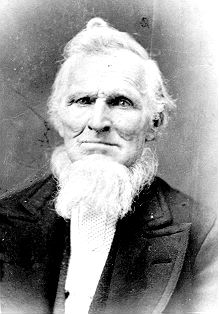
Not long after
this matter was settled, another child and only daughter, Cornelia
Elizabeth, was born September 18, 1844 in Navuoo. Persecution
continued as the Saints continued work on the temple. Orange
undoubtedly contributed his share of labor in the construction of the
temple knowing that it would have to be left behind.

The original Nauvoo Temple
After two years,
in 1849 he married Mary Elvira Tyler, a widow with two small children
of her own. She was born on April 22, 1822 in New
Haven, Oswego County, New York.
While living in
Iowa, their first child, Cyrus Adelbert (16 Oct 1849) was born.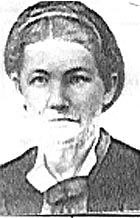
Mary Elvira Tyler
Soon after Millard County
was created on March 3, 1852, Orange Warner, Samuel B.
Hoyt, and Noah W. Bartholomew were chosen as county commissioners.
Noah Bartholomew was called as the Bishop with Samuel Hoyt and
Orange Warner were his counselors. 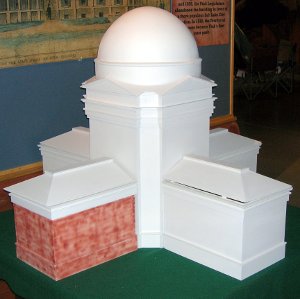
What the Capitol
Building was to look
like 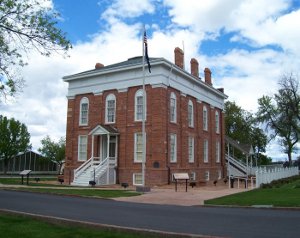
The completed
portion. A portrait
of Orange Warner
hangs in the building
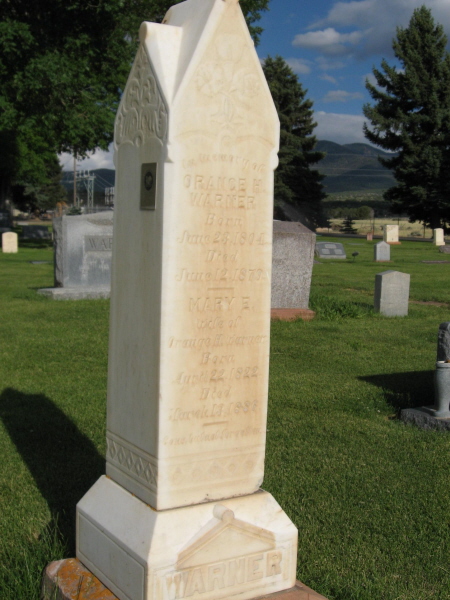
* * * * * * *
The main sources of this story were from the various writings of Lavina Warner Alger.
Details of the Easton Kelsey Company are from trail exerts found at:
http://www.lds.org/churchhistory/library/pioneercompany/1,15797,4017-1-175,00.html
Items involving the settlement of Fillmore, Utah are from Pioneer Pathways, volume 6, published by Daughters of Utah and 100 Years of History of Millard County also published by Daughters of Utah